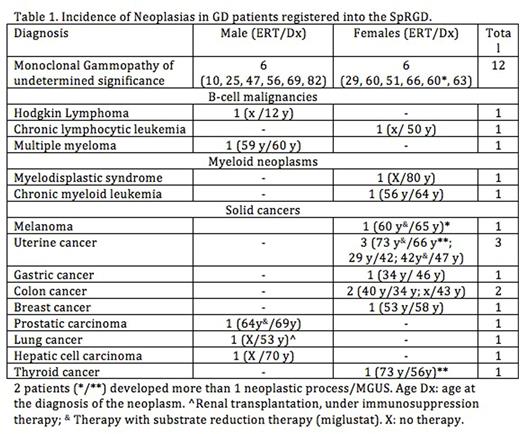Abstract
Introduction: Patients with type1 Gaucher's disease (GD1) have an increased risk of gammopathy (RR,33 Taddei TH 2009), multiple myeloma (RR,25.), other haematological malignancies (RR,3.45) and overall cancer risk (RR, 1.80). The Spanish Registry of Gaucher Disease (SpRGD) was established in 1993 in response to the need to group individual experiences in the diagnosis and management of this disease, increasing knowledge related to general characteristics and to know the real incidence and prevalence in the Spanish population. Registration is open to all physicians involved in the management of patients with GD and offers free enzymatic analysis, biomarkers and molecular analysis for the diagnosis and monitoring of patients (www.feeteg.org).
Aim: to analyses the incidence of malignancies in adults GD patients.
Patients and methods: A review of the SpRGD to obtain data form patients over 20 years of age at May, 2016 was performed. Physicians on charge fulfilled a survey in which they inform about the incidence of malignancies and follow-up information. Ethical approval was obtained from the institutional board and all patients has signed an inform consent before to be included into the SpRGD.
Results: Of the 281 adult patients (³20 years) included, 279 were GD1 and 2 GD3. The average age of the entire cohort was 52.3 (23-90), of which 140 men, 141 women. Of these, 27 (9.6%) patients with GD1, 5 homozygous for N370S and 22 heterozygous for N370S had the presence of a malignancy and / or monoclonal gammopathy (MGUS), two of them had more than one neoplasia. Male / female: 11/16, mean age 60.2 (25-90), median follow-up of 16.5 years (4-23). Six have died by the tumor complications. All MGUS (N=12) were identified at GD diagnosis, they were 6 males and 6 females mean age 55.5 y (10-82) of them 50% under 60 years of age. Sixteen patients developed seventeen different neoplasms, with a female predominant (11, 68.7%). Only eight patients were under therapy at the time of neoplasia diagnosis (table1). Mean time on therapy 7.4 years (1.2-13-6). Neoplasms were registered (M/ F): B cell malignancies: Hodgkin lymphoma 1 (M), chronic lymphocytic leukemia 1 (M), multiple myeloma 1 (M), myeloid neoplasms: chronic myeloid leukemia: 1 (F), myelodysplastic syndrome: 1 (F), solid tumors: melanoma: 1 (F), meningioma: 2 (F), uterine cancer: 3 (F), gastric carcinoma 1 (F), cancer colon 2 (F), breast cancer 1 (F), prostate adenocarcinoma: 1(M), lung cancer 1 (M), liver carcinoma 1 (M), thyroid cancer 1 (F).
Conclusions: It has been widely reported the highest incidence of haematological malignancies among patients with GD. Nevertheless in this cohort of Spanish patients, the incidence of solid tumors is similar to haematological neoplasms in general and higher than B cell lymphoid. Probably the incidence of malignancy in this population and during this monitoring period is similar to the expected in Spanish general population found in 0.21% / year, however females showed two times risk increase for malignancies and this aspect warranty further studies.
This work has been carried out with aid for research FIS PS15/00616 and FEETEG
No relevant conflicts of interest to declare.
Author notes
Asterisk with author names denotes non-ASH members.


This feature is available to Subscribers Only
Sign In or Create an Account Close Modal